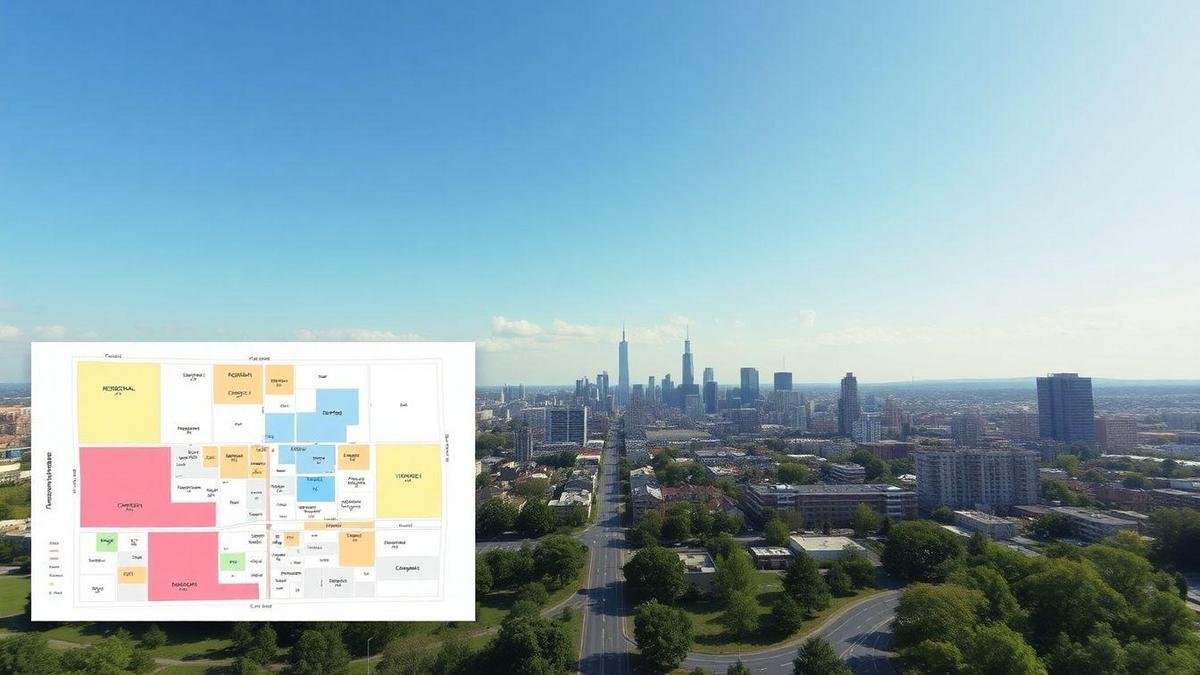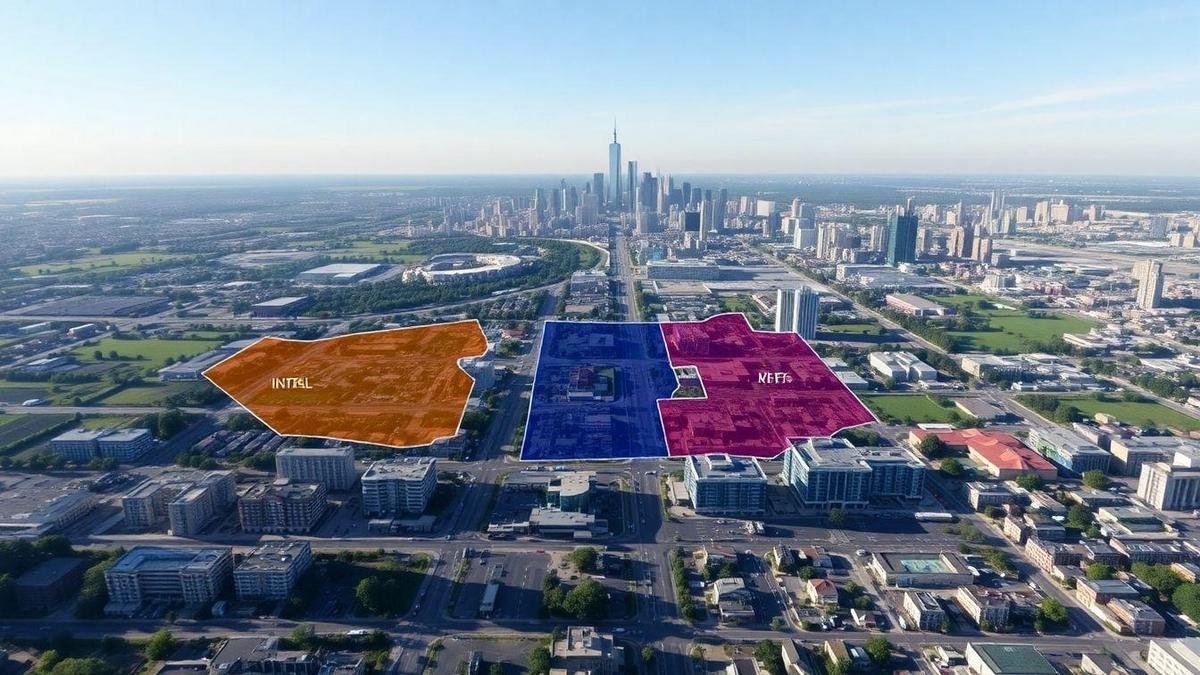The zoning change process can be a complex journey for real estate investors. This article will guide readers through essential steps, highlighting the importance of understanding local zoning regulations. It will also outline key strategies, tips, and resources to simplify applications. By focusing on best practices, challenges, and compliance, this guide aims to empower investors to navigate zoning changes effectively.
- Zoning changes can help increase property value.
- Investors should research local zoning laws, including zoning classifications.
- A clear plan can make the process easier.
- Staying organized helps reduce delays.
- Hiring experts can provide valuable support.

Understanding the Zoning Change Process
Key Steps in the Zoning Change Process
The zoning change process is vital for land development. It involves several key steps that investors must follow:
- Research Local Zoning Laws: Familiarize yourself with local zoning laws to understand what changes are possible, including land use restrictions.
- Prepare a Proposal: A clear proposal detailing the desired zoning change is essential, including how the change will benefit the community.
- Public Notification: Notify the public about the proposed change, often involving posting signs and sending letters to nearby residents.
- Public Hearing: Attend public hearings where community members voice their opinions. Be prepared to address concerns and answer questions.
- Approval Process: After the hearing, the local zoning board will review the proposal and decide whether to approve or deny the request.
- Final Decision: If approved, the zoning change becomes official. If denied, you may need to revise your proposal or appeal the decision.
Importance of Zoning Change for Investors
For investors, understanding the zoning change process is crucial. It opens doors to new opportunities and can significantly impact property value. A successful zoning change can lead to:
- Increased property value
- Greater development potential
- Enhanced community support

Zoning Permits for Investors
Types of Zoning Permits Available
Investors can encounter various zoning permits that dictate how land can be used. Here are some common types:
- Residential Zoning Permits: Allow for housing developments, such as single-family homes or apartment complexes.
- Commercial Zoning Permits: Needed for businesses, including retail stores and office buildings.
- Industrial Zoning Permits: For factories and warehouses, focusing on manufacturing and storage.
- Mixed-Use Zoning Permits: Allow for a combination of residential, commercial, and sometimes industrial uses in one area.
How to Apply for Zoning Permits
The application process for zoning permits can seem tricky, but it’s straightforward when broken down into steps:
- Research Local Zoning Laws: Understand the specific zoning regulations in the area where the property is located.
- Prepare Required Documents: Gather necessary paperwork, including site plans, project descriptions, and any environmental assessments.
- Submit Application: File the application with the local zoning office, along with any fees.
- Attend Public Hearings: Present the project to local authorities and address any community concerns.
- Await Decision: After review, the zoning authority will approve or deny the application.
Common Challenges in Obtaining Zoning Permits
Investors often face hurdles during the zoning change process. Here are some common challenges:
- Community Opposition: Local residents may oppose new developments, leading to concerns about traffic, noise, or changes in neighborhood character.
- Regulatory Delays: The approval process can take longer than expected due to bureaucratic procedures.
- Complex Regulations: Zoning laws can vary significantly from one area to another, making it essential to navigate these complexities carefully.
- Environmental Concerns: Projects may require additional assessments if they impact local ecosystems, adding more steps to the process.
Understanding these challenges can help investors prepare and adapt their strategies accordingly.

Easy Zoning Applications
Simplifying the Application Process
The zoning change process can often feel like a maze, with many twists and turns. However, simplifying this process is crucial for global investors looking to develop land efficiently. By breaking down the steps and making them clearer, investors can save time and resources.
A streamlined application involves understanding local regulations and requirements. This means knowing what is needed before submitting an application. For instance, knowing the types of zoning classifications and what they allow can make a significant difference.
Tools to Make Zoning Applications Easier
Several tools are available to assist investors in navigating the zoning change process. These tools can help organize documents, track deadlines, and even provide templates for applications. Some popular tools include:
| Tool Name | Purpose |
|---|---|
| ZoningCheck | Tracks zoning regulations and changes |
| LandUsePro | Provides application templates |
| PermitTracker | Monitors application status |
These tools can make the process feel less overwhelming, acting like a compass, guiding investors through the often complicated landscape of zoning applications.
Resources for Streamlined Zoning Applications
Investors can also tap into various resources to help with zoning applications. Local government websites often have valuable information, including:
- Guidelines for applications
- Contact information for zoning officials
- Public forums for community input
Networking with local real estate professionals can also provide insights. They often have firsthand experience with the zoning change process and can offer advice on what works and what doesn’t.

Real Estate Zoning Tips
Best Practices for Navigating Zoning Laws
Understanding zoning laws is crucial for any real estate investor. These laws dictate how land can be used, which can significantly impact property values and investment potential. Here are some best practices to follow:
- Know the Zones: Familiarize yourself with different zoning classifications in your area. For instance, residential, commercial, and industrial zones each have distinct rules.
- Consult Local Authorities: Always reach out to local planning departments for insights into zoning regulations and any upcoming changes.
- Stay Updated: Zoning laws can change, so keeping an eye on local government meetings or subscribing to newsletters from planning departments is important.
How to Research Zoning Regulations
Researching zoning regulations requires a strategic approach. Here are steps to follow:
- Visit Local Government Websites: Most municipalities have their zoning laws available online. This is a good starting point.
- Attend Community Meetings: Local meetings often discuss zoning changes. Engaging with the community can provide valuable insights.
- Utilize Zoning Maps: Many cities provide zoning maps that visually display the zoning classifications. These maps are helpful for quick reference.
Essential Tips for Real Estate Investors
Investors should keep a few essential tips in mind while navigating the zoning change process:
| Tip | Description |
|---|---|
| Understand the Process | Familiarize yourself with how zoning changes are proposed and approved. |
| Engage with Neighbors | Building relationships with local residents can help in understanding community sentiments about potential changes. |
| Document Everything | Keep records of all communications and documents related to zoning. This can be useful if disputes arise. |
By following these guidelines, investors can better position themselves in the competitive landscape of real estate.

Zoning Regulations for Investment
Understanding Local Zoning Regulations
Local zoning regulations play a crucial role in land development. They dictate how land can be used in specific areas. These rules can vary significantly from one location to another. For instance, some areas may allow residential buildings, while others may be designated strictly for commercial use. Investors must familiarize themselves with these regulations to make informed decisions.
Key aspects of local zoning regulations include:
- Types of Zoning: Residential, commercial, industrial, and agricultural.
- Permitted Uses: What activities are allowed on the property?
- Building Restrictions: Height, size, and design limitations.
- Setbacks and Lot Coverage: How much of the land can be built upon and how far structures must be from property lines.
How Regulations Affect Investment Opportunities
Zoning regulations can either open doors or close them for potential investments. For instance, an area designated for commercial use may attract businesses looking to set up shop. This can lead to increased property values and potential profits for investors. Conversely, strict zoning laws can limit the types of developments allowed, making it challenging for investors to capitalize on certain opportunities.
Consider the following table that outlines how different zoning classifications can impact investment:
| Zoning Type | Potential Investment Opportunities | Risks |
|---|---|---|
| Residential | Single-family homes, apartments | Market saturation, lower demand |
| Commercial | Retail spaces, offices | Economic downturns, high competition |
| Industrial | Warehouses, manufacturing facilities | Environmental regulations, noise issues |
| Mixed-Use | Live-work spaces, shopping centers | Complex regulations, community pushback |
Adapting to Changing Zoning Regulations
Zoning laws are not static; they can change over time. Investors need to stay informed about the zoning change process to adapt their strategies. For example, a city may decide to rezone an area to encourage development, creating new investment opportunities. However, the opposite can also occur, where an area becomes more restrictive, limiting investment potential.
To navigate these changes effectively, investors should:
- Monitor Local Government Meetings: Stay updated on proposed changes.
- Engage with Local Communities: Understand the needs and concerns of residents.
- Consult with Professionals: Work with real estate agents, lawyers, and planners who specialize in zoning.

Streamline Zoning Changes
Techniques to Speed Up Zoning Changes
The zoning change process can often feel like a tangled web. However, several techniques can help investors navigate this maze more effectively. First, establishing a strong community connection is essential. Engaging with local residents can foster goodwill and address concerns before they become obstacles.
Another effective technique is to leverage technology. Utilizing online platforms for public engagement can streamline feedback and communication. This not only saves time but also enhances transparency.
Lastly, having a clear and concise proposal can make a world of difference. Investors should focus on presenting their plans in a straightforward manner, highlighting benefits for the community and local economy.
The Role of Local Governments in Zoning Changes
Local governments play a pivotal role in the zoning change process. They serve as gatekeepers, ensuring that changes align with community goals and regulations. Understanding their priorities can provide investors with an edge.
Local governments often seek to balance development with community needs. They may prioritize affordable housing, green spaces, or infrastructure improvements. Investors should be aware of these priorities and tailor their proposals accordingly.
Moreover, local officials can offer valuable insights into the zoning change process. Engaging with them early can help investors identify potential roadblocks and streamline their applications.
Strategies for Effective Zoning Change Requests
When it comes to submitting a zoning change request, several strategies can increase the likelihood of success:
- Research Thoroughly: Familiarize yourself with local zoning laws and previous requests. Understanding the landscape can provide a competitive edge.
- Build Alliances: Form partnerships with local stakeholders to create a supportive network, including community groups, businesses, and local government officials.
- Prepare Detailed Documentation: A well-prepared request should include maps, plans, and economic impact studies. Clear documentation can make the case more compelling.
- Communicate Clearly: Be ready to explain your vision in simple terms to help demystify the proposal for those unfamiliar with technical jargon.
- Be Open to Feedback: Flexibility can be a strong asset. Being willing to adjust plans based on community input can foster goodwill and improve the chances of approval.
By employing these strategies, investors can enhance their chances of successfully navigating the zoning change process.

Zoning Maps for Investors
How to Read Zoning Maps
Reading zoning maps can be a game-changer for investors. These maps display how land can be used in specific areas. Each color or pattern on the map represents different zoning classifications, such as residential, commercial, or industrial.
To make sense of these maps, pay attention to the legend. The legend explains what each color means. For instance, green might indicate parks, while blue could show commercial areas.
Here’s a quick breakdown of common zoning types:
| Zoning Type | Description |
|---|---|
| Residential | Areas for homes and apartments |
| Commercial | Places for businesses and shops |
| Industrial | Zones for factories and warehouses |
| Agricultural | Land for farming and agriculture |
By understanding these categories, investors can identify potential opportunities in the market.
Utilizing Zoning Maps for Investment Decisions
Zoning maps are invaluable tools for making informed investment choices. They help investors pinpoint areas with growth potential. For example, if a zoning change process is underway in a specific area, it could lead to increased property values.
Investors should consider the following when using zoning maps:
- Future Developments: Look for areas marked for future growth.
- Compatibility: Ensure the zoning aligns with your investment goals.
- Restrictions: Be aware of any limitations on property use.
By analyzing these factors, investors can make smarter decisions that align with their financial goals.
Importance of Accurate Zoning Maps
Accurate zoning maps are crucial for any investor. They provide a clear picture of what can and cannot be done with a piece of land. Inaccuracies can lead to costly mistakes. For instance, purchasing land thinking it can be developed commercially, only to find it is zoned residential, can derail an investment plan.
Investors should always verify zoning information through local government resources. This step is essential to avoid complications later on.

Zoning Compliance Guide
Ensuring Compliance with Zoning Laws
Navigating zoning laws is crucial for any investor in land development. These regulations dictate how land can be used, whether for residential, commercial, or industrial purposes. Understanding these laws helps in making informed decisions. Investors should conduct thorough research to identify the zoning classification of their property, often found on local government websites or by contacting planning departments directly.
Key factors to consider include:
- Zoning classifications: Knowing the specific category of the property.
- Permitted uses: Understanding what activities are allowed under the zoning classification.
- Setback requirements: Recognizing how far structures must be from property lines.
Consequences of Non-Compliance
Failing to adhere to zoning laws can lead to significant repercussions, including:
- Fines and penalties: Local authorities may impose financial penalties for violations.
- Legal action: Investors could face lawsuits or injunctions from neighbors or local governments.
- Loss of investment: In severe cases, properties may be deemed unusable, leading to financial loss.
Understanding the ramifications of non-compliance is essential for protecting investments.
Steps to Maintain Zoning Compliance
To stay compliant with zoning laws, investors should follow these steps:
- Regularly review zoning regulations: Laws can change, so staying updated is vital.
- Engage with local authorities: Building relationships with local planners can provide insights and guidance.
- Consider the zoning change process: If a property does not meet current zoning requirements, exploring the zoning change process may be necessary.
| Step | Action |
|---|---|
| 1 | Review local zoning regulations regularly |
| 2 | Engage with local planning authorities |
| 3 | Explore the zoning change process if needed |
By following these steps, investors can navigate the complexities of zoning compliance more effectively.

Zoning Change Strategies
Developing Effective Zoning Change Strategies
To navigate the zoning change process, investors must craft strategies that are both practical and impactful. A well-thought-out approach can lead to successful outcomes in land development. Here are some essential steps to consider:
- Research Local Regulations: Understanding the specific zoning laws in the area is crucial. Each locality has its own rules, and knowing them can save time and resources.
- Engage with Stakeholders: Building relationships with local officials, community members, and other stakeholders is vital. Their support can greatly influence the success of zoning changes.
- Create a Solid Proposal: A clear and detailed proposal that outlines the benefits of the zoning change can persuade decision-makers. It should highlight how the change aligns with community goals.
- Utilize Data and Evidence: Presenting data that supports the need for zoning changes can strengthen the argument. This may include economic forecasts, population growth statistics, and examples of similar successful projects.
- Plan for Community Engagement: Hosting public meetings or forums can help address community concerns and allow for feedback that can refine the proposal.
Case Studies of Successful Zoning Changes
Examining real-life examples can provide valuable insights into effective zoning change strategies. Here are a couple of notable case studies:
| Case Study | Location | Outcome |
|---|---|---|
| Downtown Revitalization | Springfield, IL | Increased foot traffic and business growth. |
| Mixed-Use Development | Austin, TX | Enhanced community living and local economy. |
Learning from Zoning Change Success Stories
Success stories often highlight key lessons for future zoning change efforts. For instance, in Springfield, community engagement played a pivotal role. Local residents were involved in the planning process, leading to greater acceptance and support.
In Austin, the mixed-use development not only met housing needs but also fostered a vibrant community atmosphere. These examples underline the importance of collaboration and thorough planning in the zoning change process.
In the End…
Navigating the zoning change process is no small feat for real estate investors. It requires a keen understanding of local regulations, strategic planning, and effective communication with community stakeholders. By following the outlined steps and best practices, investors can enhance their chances of success, turning potential hurdles into stepping stones. The journey may be complex, but with the right tools and resources, it can lead to lucrative opportunities and increased property values. As they embark on this journey, investors are encouraged to remain proactive, agile, and informed. For further insights and resources on real estate and zoning, readers are invited to explore more articles at Land Development Hub.
Eduardo Bugallo, PhD.

2 Responses
[…] Regulatory Risk: Changes in laws or zoning regulations can halt or delay projects. For a guide on navigating these laws, see navigating zoning changes. […]
[…] Development Checklist For Smart Investors on Zoning Change Process Made Easy for InvestorsAugust 25, […]